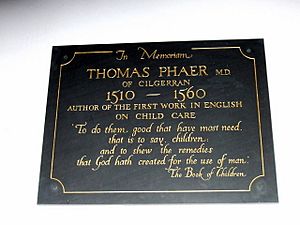Thomas Phaer facts for kids
Thomas Phaer (born around 1510, died August 12, 1560) was an English lawyer, doctor, and writer. He wrote The Boke of Chyldren in 1545. This was the very first book about children's health written in English. Because of this, many people call him "the Father of English Pediatrics."
Contents
Who Was Thomas Phaer?
Thomas Phaer was likely born in Norwich, England. His father, also named Thomas, came from Flanders (a region in modern-day Belgium). Phaer went to Oxford University to study. He then studied law at Lincoln's Inn in London.
He became a lawyer for the Court of the Welsh Marches. This court handled legal matters in the border areas between England and Wales. When he got this job, he moved to Cilgerran, a town in Wales. He lived there until he passed away.
His Time in Politics
Thomas Phaer was also involved in politics. He became a Member of Parliament (MP) for different areas in Wales. He represented Carmarthen Boroughs in 1547. Later, he was an MP for Cardigan from 1555 to 1559.
Becoming a Doctor
Even though he was a lawyer and politician, Phaer also practiced medicine. He started working as a doctor in the 1530s, when he was in his mid-twenties. In 1558, he applied to Oxford University for a medical degree. He said he had been practicing medicine for 20 years. That same year, he earned both a Bachelor of Medicine and a Doctor of Medicine degree.
Thomas Phaer died in Cilgerran in 1560. He was buried in the local church. He left behind his wife, Ann, and their three daughters: Eleanor, Mary, and Elizabeth. Today, he is honored by the Royal College of Paediatrics and Child Health. His image is on their coat of arms, showing his importance in children's medicine.
What Did Thomas Phaer Write?
Thomas Phaer wrote several important books. In 1535, he published Natura brevium, a legal book. He also wrote Newe Boke of Presidentes in 1543, which was another legal guide.
His Medical Books
Phaer became well-known for his medical writings. In 1544, he published The Regiment of Life. This book was a translation of a French text about healthy living. The next year, in 1545, he published his most famous work: The Boke of Chyldren. This book was added to The Regiment of Life.
Why The Boke of Chyldren Was Important
The Boke of Chyldren was a very important book for its time. It was one of the first books to say that children are different from adults. It treated children as special patients with their own health needs.
Phaer wrote about many illnesses that children could get. These included "apostume of the brayne" (which sounds like meningitis) and "terrible dreames and feare in the slepe" (nightmares). He also gave smart advice. For example, he said not to use too many medicines for diseases like smallpox or measles. He believed nature should be allowed to heal.
Phaer also thought doctors should write in English, not just Latin. He wanted everyone to understand medical advice. He asked, "Why grutche they phsyicke to come forth in Engliyshe?" He believed medical knowledge should be shared, not kept secret.
His Other Writings
Phaer also contributed to a book called Mirrour for Magistrates. He wrote a section about a Welsh leader named Owen Glendower.
In his later years, Phaer became famous for translating Virgil's Aeneid. This was a very long and famous Latin poem. He published The Seven First Bookes of the Eneidos of Virgil converted into English Meter in 1558. He had translated two more books and started a tenth before he died in 1560. Another writer, Thomas Twyne, finished the translation in 1584. Phaer's translation was very popular for many years.
List of Thomas Phaer's Works


